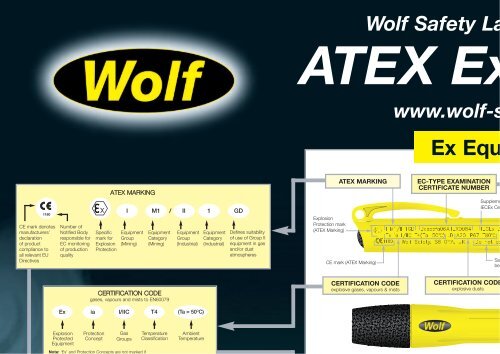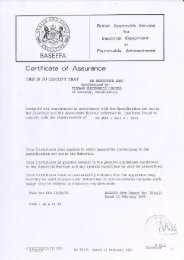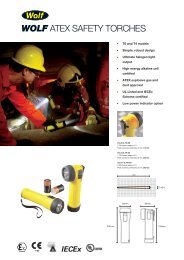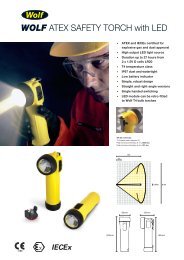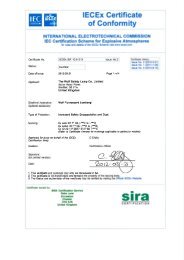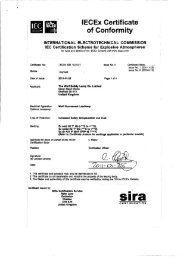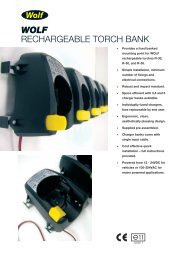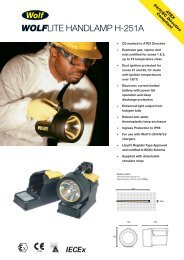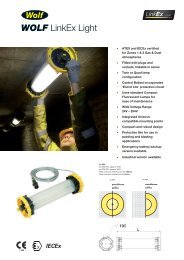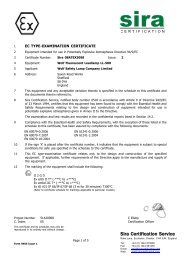12805 ATEX poster 09 - Wolf Safety Lamp Company
12805 ATEX poster 09 - Wolf Safety Lamp Company
12805 ATEX poster 09 - Wolf Safety Lamp Company
Create successful ePaper yourself
Turn your PDF publications into a flip-book with our unique Google optimized e-Paper software.
1180<br />
CE mark denotes<br />
manufacturers’<br />
declaration<br />
of product<br />
compliance to<br />
all relevant EU<br />
Directives<br />
Number of<br />
Notified Body<br />
responsible for<br />
EC monitoring<br />
of production<br />
quality<br />
Explosion<br />
Protected<br />
Equipment<br />
<strong>ATEX</strong> MARKING<br />
CERTIFICATION CODE<br />
gases, vapours and mists to EN60079<br />
Ex ia I/IIC T4 (Ta = 50 O C)<br />
Protection<br />
Concept<br />
Specific<br />
mark for<br />
Explosion<br />
Protection<br />
Gas<br />
Groups<br />
I M1 / II 1 GD<br />
Equipment<br />
Group<br />
(Mining)<br />
Note: ‘Ex’ and Protection Concepts are not marked if<br />
Equipment<br />
Category<br />
(Mining)<br />
Temperature<br />
Classification<br />
Equipment<br />
Group<br />
(Industrial)<br />
Ambient<br />
Temperature<br />
Equipment<br />
Category<br />
(Industrial)<br />
Defines suitability<br />
of use of Group II<br />
equipment in gas<br />
and/or dust<br />
atmospheres<br />
<strong>Wolf</strong> <strong>Safety</strong> La<br />
<strong>ATEX</strong> Ex<br />
Explosion<br />
Protection mark<br />
(<strong>ATEX</strong> Marking)<br />
<strong>ATEX</strong> MARKING EC-TYPE EXAMINATION<br />
CERTIFICATE NUMBER<br />
CE mark (<strong>ATEX</strong> Marking)<br />
CERTIFICATION CODE<br />
explosive gases, vapours & mists<br />
www.wolf-s<br />
Ex Equ<br />
Suppleme<br />
IECEx Ce<br />
Saf<br />
be<br />
CERTIFICATION CODE<br />
explosive dusts
mp <strong>Company</strong><br />
plained<br />
afety.co.uk<br />
ipment<br />
ntary approval,<br />
tificate Number<br />
ety measures to<br />
applied in service<br />
Serial/batch number, incorporating<br />
year of construction<br />
Replacement parts specification<br />
MARKING FOR DUST PROTECTION<br />
to EN 61241-0 and EN 61241-1<br />
Ex tD A20 IP67 T80 O C<br />
Explosion<br />
Protected<br />
Equipment<br />
Protection<br />
Concept<br />
Notified body<br />
responsible for<br />
EC-Type<br />
Examination<br />
(Test House)<br />
EC-TYPE EXAMINATION CERTIFICATE NUMBER<br />
Baseefa 06 <strong>ATEX</strong> 0084<br />
<strong>ATEX</strong> Certificate<br />
Serial<br />
Number<br />
X Suffix denotes special conditions of certification U Suffix denotes Ex component approval<br />
Allowable Dust<br />
Zone (assessed<br />
using 'practice A' -<br />
only applicable to tD)<br />
Year Certificate Issued<br />
Ingress<br />
Protection<br />
Code<br />
Maximum<br />
External Surface<br />
Temperature<br />
EC NOTIFIED BODIES<br />
Notified Bodies have been appointed<br />
by the governments of individual EC<br />
countries as responsible to carry out<br />
part or all of the functions specified in<br />
the <strong>ATEX</strong> Equipment Directive, such<br />
as EC type examination of equipment<br />
and quality assurance assessment of<br />
equipment production.<br />
Baseefa (2001) Ltd are responsible for<br />
the quality assurance assessment of<br />
equipment manufactured by the <strong>Wolf</strong><br />
<strong>Safety</strong> <strong>Lamp</strong> <strong>Company</strong>, this is identified<br />
by their notified body number (1180)<br />
appearing below the CE mark on
�� �� � � �� � �less<br />
energy required<br />
more<br />
to ignite gas<br />
Mining<br />
Industrial<br />
a ‘Technical File’ from first principles is applied.<br />
EQUIPMENT GROUP & EQUIPMENT CATEGORY<br />
Equipment Equipment Protection Hazard Use<br />
Group Category Level<br />
Gas Dust<br />
I M1 Very high – – Operable in Ex<br />
protection atmosphere<br />
M2 High – – De-energised<br />
protection in Ex atmosphere<br />
II 1 Very high<br />
protection<br />
G Zones 0,1,2,<br />
D Zones 20,21,22<br />
2 High<br />
protection<br />
G Zones 1,2<br />
D Zones 21,22<br />
3 Normal<br />
protection<br />
G Zones 2<br />
D Zones 22<br />
Equipment Group and Category identify the areas in which equipment may be safely used<br />
‘CE’ MARKING AND THE 94/9/EC <strong>ATEX</strong> DIRECTIVE ON EQUIPMENT AND<br />
PROTECTIVE SYSTEMS INTENDED FOR USE IN POTENTIALLY EXPLOSIVE<br />
ATMOSPHERES.<br />
MANDATORY WITHIN THE EU.<br />
‘CE’ marking has been introduced as part of the European Union’s new approach to<br />
technical harmonisation as a means of identifying products that comply with all relevant<br />
EC Directives.<br />
Subject to certain safeguards, products bearing the ‘CE’ mark are permitted to be sold<br />
throughout the EU without interference from national regulatory authorities. The Directives<br />
have been put in place in order to remove artificial trade barriers within the European Union previously caused<br />
by individual countries’ national standards, a secondary function is as a means of regulating safety.<br />
The Explosive Atmospheres 94/9/EC <strong>ATEX</strong> (Equipment) Directive became mandatory on 1 July 2003.<br />
On this date the existing Explosive Atmospheres and Gassy Mines Directives were repealed. Since then only<br />
equipment and systems ‘CE’ marked as compliant with the <strong>ATEX</strong> Equipment Directive (and all other relevant<br />
mandatory directives) may placed on the market within the EU.<br />
The Directive applies to all equipment and systems for use in potentially explosive atmospheres within the EU.<br />
The scope of the Directive includes electrical and mechanical equipment for use in Group I (mining) or Group II<br />
(industrial) applications, both on and offshore and considers risks of ignition of potentially explosive gas,<br />
vapour, mist and dust atmospheres. In addition, devices intended for use outside potentially explosive<br />
atmospheres that contribute to the safe functioning of equipment and systems with regard to explosion risk<br />
are also included.<br />
Compliance of products to the <strong>ATEX</strong> Equipment Directive, through conformity assessment, takes a modular<br />
approach, and is generally in two stages; design and production.<br />
A common route to product design compliance is to apply to a Notified Body (Ex. Test House) for an EC<br />
���<br />
Mining<br />
Industrial<br />
Concept<br />
General req.<br />
Flameproof<br />
Pressurised<br />
Powder filled<br />
Oil immersion<br />
Increased<br />
safety<br />
��<br />
����<br />
�GAS GROUP<br />
Group Typical Hazard Maximum Safe Maximum<br />
Sparking Energy Flamepro<br />
Intrinsic <strong>Safety</strong> Ex ia/ib<br />
I Methane<br />
✓<br />
IIA Propane<br />
✓<br />
IIB Ethylene<br />
✓<br />
IIC Hydrogen/Acetylene<br />
✓<br />
II All Gases<br />
Equipment sub-grouping segregates gases according to ease of ignitability by sparks<br />
intrinsically safe Ex ia/ib equipment only.<br />
CONCEPTS FOR ELECTRICAL APPARATUS<br />
Symbol Icon<br />
Description Category EN Standa<br />
–<br />
General requirements – EN 60079-<br />
Ex d<br />
ignition within the apparatus 2 EN 60079enclosure<br />
is contained and<br />
will not ignite surrounding<br />
explosive atmosphere<br />
Ex p<br />
explosive gas excluded 2 EN 60079by<br />
surrounding ignition<br />
source with pressurised<br />
inert gas<br />
Ex q��PROTECTION<br />
explosive gas excluded 2 EN 60079by<br />
immersing ignition<br />
source in sand<br />
Ex o<br />
explosive gas excluded<br />
by immersing ignition<br />
source in oil<br />
2 EN 60079-<br />
Ex e<br />
design excludes<br />
the possibility of<br />
2 EN 60079-<br />
narrow flameproof wide<br />
���<br />
���<br />
��<br />
��
�� ��<br />
�gap size<br />
���<br />
��<br />
Safe Gap Applicable<br />
f Ex d Concepts<br />
✓<br />
✓<br />
✓<br />
✓<br />
all concepts<br />
Ex d, Ex i<br />
Ex e, Ex m, Ex p,<br />
Ex o, Ex q, Ex n<br />
r flames. These apply to flameproof Ex d and<br />
rd<br />
0<br />
1<br />
2<br />
5<br />
6<br />
7<br />
TEMPERATURE CLASS<br />
GROUP II GAS SUBDIVISION<br />
IIA<br />
IIB<br />
IIC<br />
IIA IIB IIC<br />
Potentially<br />
Explosive<br />
Atmosphere<br />
Temperature class relates to the hot surface ignition temperature of a particular explosive<br />
atmosphere. It must not be exceeded by the temperature classification of the equipment<br />
intended to be used in that atmosphere.<br />
Hot surfaces can ignite explosive atmospheres<br />
Equipment<br />
450°C<br />
300°C<br />
200°C<br />
135°C<br />
Risk of ignition<br />
II<br />
Explosion<br />
Protected<br />
Equipment<br />
�<br />
Risk of ignitionExplosion Protected<br />
T1<br />
T2<br />
T3<br />
T4<br />
T5<br />
��<br />
��<br />
����<br />
�<strong>Wolf</strong> products.<br />
PROTECTION CONCEPTS<br />
FOR ELECTRICAL APPARATUS<br />
Concept Symbol Symbol<br />
Description Category EN Standard<br />
General req. –<br />
General requirements – EN 61241-0<br />
Enclosure Ex tD<br />
enclosure is sealed against 1/2/3 EN 61214-1<br />
dust ingress, design<br />
excludes the possibility of<br />
enclosure failure<br />
Pressurised Ex pD<br />
flammable dust excluded 2/3 EN 61214-2<br />
by surrounding ignition<br />
source with pressurised<br />
inert gas<br />
Ex iaD<br />
energy in circuit and 1 EN 61241-11<br />
Ex ibD<br />
temperature on<br />
2<br />
Ex icD<br />
components reduced 3<br />
to a safe level<br />
��DUST<br />
Ex mD<br />
flammable dust excluded 1/2/3 EN 61241-18<br />
by encapsulating the<br />
ignition source in resin<br />
INGRESS PROTECTION (IP) CODE to EN 60529<br />
Ex equipment selection for use in gases, vapours, mists or dusts must take into consideration the<br />
environmental conditions of the area in which it is to be used. Apparatus resistance to ingress of both<br />
solid bodies and water is identified by use of an “IP rating”.<br />
1st Numeral Protection Against Solid Bodies 2nd Numeral Protection Against Water<br />
Intrinsic <strong>Safety</strong><br />
Encapsulation<br />
���<br />
��<br />
�<br />
no protection<br />
> 12.5mm<br />
> 1mm<br />
> 50mm<br />
> 2.5mm<br />
0 0<br />
1 1<br />
2 2<br />
3 3<br />
4 4<br />
5 5<br />
90∞<br />
60∞<br />
no protection<br />
15∞<br />
360∞
�� �� � ���<br />
��<br />
Type Examination Certificate. To comply, the equipment or system must meet the Essential Health and <strong>Safety</strong><br />
Requirements (EHSRs) listed in the Directive. Harmonised EU standards have been adopted by CENELEC and<br />
CEN, relating to the design, construction and testing of equipment; a product complying with these standards<br />
is deemed to meet the EHSRs to which the standards relate. Where apparatus follows a protection concept<br />
not covered by these standards, compliance to the 94/9/EC Directive is still possible by compiling a ‘Technical<br />
File’ from first principles, demonstrating compliance through test and assessment to the EHSRs relating to<br />
design and construction of equipment for use in explosive atmospheres.<br />
The production quality stage of the conformity assessment procedures ensure continued product compliance<br />
in manufacturing. Typically a manufacturer should have a certified ISO 9000 quality management system and<br />
comply with one of the quality modules in the <strong>ATEX</strong> Equipment Directive, however this will vary depending on<br />
product equipment category; equipment used in higher risk areas will require more onerous conformity<br />
assessment procedures to be applied.<br />
In addition to the 94/9/EC <strong>ATEX</strong> (Equipment) Directive, products for use in potentially explosive atmospheres<br />
may require to be compliant with other Directives including the 2004/108/EC Electro-Magnetic Compatibility<br />
(EMC) Directive. This Directive applies to virtually all electrical and electronic apparatus potentially able to<br />
generate interfering emissions or exhibit an undue sensitivity to interference sources.<br />
Once compliance with the relevant Directives is complete and an EC Declaration of Conformity issued by the<br />
manufacturer, the ‘CE’ mark may be applied and the product placed on the market.<br />
The <strong>ATEX</strong> Equipment Directive in full, and EC Commission guidance on the Directive, may be found on the<br />
following website: http://ec.europa.eu/enterprise/atex/direct/text94-9-en.pdf<br />
�<br />
99/92/EC <strong>ATEX</strong> (WORKPLACE) DIRECTIVE ON MINIMUM REQUIREMENTS<br />
FOR IMPROVING THE SAFETY AND HEALTH PROTECTION OF WORKERS<br />
POTENTIALLY AT RISK FROM EXPLOSIVE ATMOSPHERES.<br />
MANDATORY WITHIN THE EU.<br />
The Directive covers both Group I and Group II activities, on shore and offshore within<br />
the EU, and aims to provide a better level of protection for the health and safety of<br />
workers in potentially explosive gas, vapour, mist and dust atmospheres.<br />
It lists a set of obligations and safety measures for employers, requiring the adoption<br />
of a coherent risk assessment based strategy for the prevention of explosions.<br />
These obligations include:<br />
• Generation of an explosion protection document, evaluating explosion risk, including: likelihood of<br />
the presence of the explosive atmosphere, the presence of ignition sources (including electrostatic<br />
discharge), identification of the substances and processes in use, definition of specific measures<br />
taken to safeguard the health and safety of workers.<br />
• Classification of areas into zones and marking points of entry with safety signs.<br />
• Appropriate training and supervision for workers.<br />
• Use of written instructions and permits to work.<br />
• Special requirements for work equipment:-<br />
– Equipment in service before 30 June 2003 may continue to be used after this date if it has been risk<br />
assessed and the explosion protection document indicates it can be safely used.<br />
– Equipment brought into service after 30 June 2003 must be CE marked as compliant with the<br />
94/9/EC <strong>ATEX</strong> (Equipment) Directive.<br />
• Due consideration of explosion protection measures, encompassing issues such as:<br />
– Control of releases.<br />
– Use of protective measures appropriate to the greatest potential risk.<br />
– Selection of appropriate equipment by referencing the explosion protection document.<br />
– Ensuring equipment is correctly maintained and operated.<br />
– Minimising the risk of explosion and the effect of explosion in the workplace.<br />
– Provision of suitable warning and escape facilities.<br />
99/92/EC is a separate directive specifically covering workers in explosive atmospheres,<br />
working within the more general 89/391/EEC Directive on the introduction of measures to<br />
Intrinsic safety<br />
Non-incendive��Area<br />
Encapsulation<br />
Ex ia<br />
Ex ib<br />
Ex ic<br />
Ex nA<br />
Ex nL<br />
Ex nR<br />
Ex nC<br />
Ex ma<br />
Ex mb<br />
Ex mc��<br />
����<br />
�incendive arcs, sparks<br />
or hot surfaces<br />
energy in circuit and 1 EN 60079-1<br />
temperature on<br />
2<br />
components reduced 3<br />
to a safe level<br />
will not ignite explosive 3 EN 60079-1<br />
gas in normal operation,<br />
faults unlikely to occur<br />
flammable gas excluded 1 EN 60079-1<br />
by encapsulating the 2<br />
ignition source in resin 3<br />
Protection concept identifies the means by which explosion protection is achieved.<br />
Classification<br />
Gases Dusts<br />
Zone Criteria<br />
CLASSIFICA<br />
HAZARDOU<br />
Zone 0<br />
present continuously or for long periods<br />
(>1000hrs per annum)<br />
To EN 60079-10<br />
Hazardous areas<br />
Zone 20<br />
into zones on the<br />
frequency and d<br />
Zone 1<br />
Zone 21<br />
likely to occur in normal operation occasionally<br />
(>10hrs,
1<br />
5<br />
8<br />
100°C<br />
85°C<br />
TION OF<br />
AREAS<br />
are classified<br />
basis of the<br />
ration of the<br />
explosive<br />
ations on<br />
L STATION FORECOURT<br />
T1 T2 T3 T4 T5 T6<br />
AMBIENT TEMPERATURE<br />
Equipment approved to the<br />
CENELEC standard have T. class<br />
based on use in an ambient of<br />
-20°C to +40°C unless otherwise<br />
stated i.e. (Ta = 50°C)<br />
GARAGE<br />
UNVENTILATED<br />
GARAGE<br />
INSPECTION PIT<br />
Potentially Explosive<br />
Atmosphere<br />
T6<br />
+40 0 C<br />
–20 0 C<br />
APPARATUS GROUPS AND<br />
TEMPERATURE CLASSES FOR COMMON<br />
EXPLOSIVE GASES AND VAPOURS<br />
Gas/Vapour Gas Temperature<br />
Temperature Group Class<br />
Acetic acid IIA T1<br />
Acetone IIA T1<br />
Acetylene IIC T2<br />
Ammonia IIA T1<br />
Benzene IIA T1<br />
Butane IIA T2<br />
Cumene IIA T2<br />
Cychlohexane IIA T3<br />
Ethanol (ethyl alcohol) IIA T2<br />
Ethylene IIB T2<br />
Hydrogen IIC T1<br />
Methane (industrial) IIA T1<br />
Methanol IIA T1<br />
Petroleum IIA T1<br />
Propane IIA T1<br />
Toulene IIA T1<br />
Turpentine IIA T3<br />
Xylene IIA T1<br />
A more comprehensive list of gases and vapours<br />
is provided in IEC 60079-20<br />
KEY<br />
Explosive atmosphere consisting of a<br />
mixture with air of flammable substances<br />
in the form of gas, vapour or mist, or a<br />
cloud of combustible dust in air.<br />
1st numeral and 2nd numeral combined to<br />
identify level of ingress protection, e.g. dust<br />
tight, protected from high power water<br />
jets/heavy seas:–<br />
6 6<br />
Ingress Protection rating: I P 6 6<br />
ASSOCIATED STANDARDS<br />
7<br />
8<br />
IGNITION TEMPERATURES<br />
FOR COMMON COMBUSTIBLE DUSTS<br />
Dust type Dust Layer – Dust Cloud –<br />
minimum minimum<br />
ignition ignition<br />
temperature ( o C) temperature ( o C)<br />
Aluminium 280 530<br />
Coal 270 590<br />
Flour 470 410<br />
Grain 290 420<br />
Iron 300 310<br />
PVC 430 680<br />
Rubber 220 460<br />
Sawdust<br />
(Wood) 300 400<br />
Soot 385 620<br />
Starch 530 380<br />
Sugar 360 450<br />
A database of 'Combustion and Explosion<br />
Characteristics of Dusts’ is available<br />
at www.hvbg.de/e/bia/fac/expl/<br />
Explosive Atmospheres. Explosion prevention & protection<br />
Basic concepts and methodology EN 1127-1<br />
Electrical equipment for use in potentially explosive gases,<br />
vapours and mists<br />
Classification of hazardous areas EN 60079-10<br />
Electrical installations EN 60079-14<br />
Inspection and maintenance of electrical installations EN 60079-17<br />
Repair and overhaul of apparatus IEC 60079-19<br />
Data for flammable gases and vapours IEC 60079-20<br />
Electrical apparatus for use in the presence of combustible dusts<br />
Classification of areas EN 61241-10
encourage improvements in the safety and health of workers at work.<br />
The <strong>ATEX</strong> Workplace Directive in full may be found on the following website:<br />
http://ec.europa.eu/enterprise/atex/dir92-en.pdf<br />
DSEAR – THE DANGEROUS SUBSTANCES AND EXPLOSIVE ATMOSPHERES<br />
REGULATIONS 2002.<br />
In the UK the 99/92/EC <strong>ATEX</strong> Workplace Directive has been implemented as The Dangerous Substances<br />
and Explosive Atmospheres Regulation 2002 (DSEAR). These regulations also include the safety aspects<br />
of the 98/24/EC Chemical Agents Directive, resulting in flammable and dangerous substances being<br />
covered by a single set of regulations, thus reducing the volume of legislation covering this area.<br />
A copy of the DSEAR regulations is available at:<br />
http://www.hmso.gov.uk/si/si2002/20022776.htm<br />
A guide to DSEAR, published by the Health and <strong>Safety</strong> Executive can be downloaded at:<br />
http://www.hse.gov.uk/fireandexplosion/dsear.htm<br />
<strong>ATEX</strong> LED Worklite – WL-85/WL-80/WL-70<br />
II 2 GD Ex e ib mb IIC T4 Ex tD A21 IP65 T135°C<br />
SIRA07<strong>ATEX</strong>3027<br />
A-TL45A<br />
A-TL44A<br />
<strong>Wolf</strong> <strong>ATEX</strong> Turbolite<br />
I M2/II 2 GD II T4 (Tamb=55°C) T135°C<br />
SIRA02<strong>ATEX</strong>5<strong>09</strong>9X<br />
<strong>Wolf</strong> <strong>ATEX</strong> <strong>Safety</strong> Torches<br />
II 2 GD EEx e ib IIC T6 IP67 T65°C<br />
II 2 GD EEx e ib IIC T4 (Tamb=40/55°C)<br />
IP67 T95°C (Tamb=55°C)<br />
BAS02<strong>ATEX</strong>2220X<br />
FUEL STORAGE TANK<br />
Ex Envir<br />
This guide is provided to aid in the selection of <strong>Wolf</strong> lighting products for u<br />
practice within the EU, as specified in the requirements of the 94/9/EC ATE<br />
<strong>Wolf</strong>lite Primary Cell Handlamp H-4DCA<br />
II 2 GD EEx e ib IIC T4 IP66 T135°C<br />
BAS00<strong>ATEX</strong>2203<br />
<strong>Wolf</strong> Flameproof Leadlamp<br />
II 2 G EEx d e IIC T4/T3<br />
BVS03<strong>ATEX</strong>E279<br />
<strong>Wolf</strong> Rechargeable Torch R-30/R-50/R-55<br />
II 2 GD Ex ib IIC T4 tD A21 IP67 T85°C (R-30/R-50)<br />
II 1 G Ex ia IIC T4 IP67 (R-55)<br />
Baseefa05<strong>ATEX</strong>0068 (R-30)<br />
Baseefa05<strong>ATEX</strong>0069 (R-50/R-55)<br />
<strong>Wolf</strong> Min<br />
I M1/<br />
I M2/<br />
I M1/<br />
Baseefa0<br />
<strong>Wolf</strong> ‘Zone 0’ Headtorch HT-200<br />
II 1 G EEx ia IIC T4/T3<br />
Baseefa04<strong>ATEX</strong>0398<br />
<strong>Wolf</strong> <strong>Safety</strong> <strong>Lamp</strong> <strong>Company</strong> Saxon R<br />
tel: +44 (0) 114 255 1051 fax: +44 (0) 114 255 7988 e<br />
It is the user’s responsibility to ascertain if a particular product is safe and without risk to health and safety by virtue of its location in a hazardous area, i.e. class<br />
Whilst every care has been taken in the compilation of this document, the <strong>Company</strong> regrets that it cannot accept responsibility for any errors or omissions contained herein. Readers should no<br />
© The <strong>Wolf</strong> <strong>Safety</strong> <strong>Lamp</strong> <strong>Company</strong> Limited 2000 & 20<strong>09</strong>. Do not reproduce without prior permission from
FLAMMABLE MATERIAL<br />
IN LIQUID FORM<br />
onment<br />
ZONE 0 ZONE 1 ZONE 2<br />
se in potentially explosive atmospheres. Information given is based on<br />
X (Equipment) Directive and the 99/92/EC <strong>ATEX</strong> (Workplace) Directive.<br />
i & Micro Torches<br />
II 1 GD Ex ia I/IIC T5 (Ta=+50°C) tD A20 IP67 T80°C (M-10)<br />
II 2 GD Ex ib I/IIC T4 tD A21 IP67 T80°C (M-20)<br />
II 1 GD Ex ia I/IIC T4 (Ta=+50°C) tD A20 IP67 T80°C (M-40/M-60)<br />
6<strong>ATEX</strong>0084<br />
<strong>Wolf</strong> <strong>ATEX</strong> LED Torch<br />
I M2/II 2 GD Ex ib I/IIC T4/T3 tD A21 IP67 T85°C (TR-40/ TR-40+)<br />
I M1/II 1 G Ex ia I/IIC T4/T3 IP67 (TR-45)<br />
Baseefa07<strong>ATEX</strong>0<strong>09</strong>1<br />
<strong>Wolf</strong>lite LED Rechargeable<br />
Handlamp H-251A/LED<br />
II 2 GD EEx e ib IIC T4<br />
IP66 T135°C<br />
BAS00<strong>ATEX</strong>2176<br />
oad Works, Sheffield S8 OYA England<br />
-mail: info@wolf-safety.co.uk www.wolf-safety.co.uk<br />
ification of zones, gas groups, ignition temperatures, etc. Both the specifier and user should be thoroughly familiar with the standards mentioned in this guide.<br />
Ignition<br />
Flameproof flange gap on<br />
Ex d equipment<br />
< = less than<br />
> = more than<br />
t rely upon the information contained in this document without seeking specific safety advice and ensuring that their own particular circumstances are in accordance with the matters set out.<br />
the company. MM Design Limited, Sheffield. Printed in England MM/PRO/04.<strong>09</strong>/4K SL008 ISSUE 2<br />
<strong>Wolf</strong> Hazard <strong>Lamp</strong> HL-95<br />
II 1 G EEx ia IIC T4<br />
BAS99<strong>ATEX</strong>1044<br />
Fluorescent Leadlamp<br />
II 2 GD Ex emb II T3/T4 Ex tD A21<br />
IP66/67/68 T100°C<br />
II 2 GD Ex embd IIC T3/T4 Ex tD A21<br />
IP66 T100°C (Linkable)<br />
SIRA08<strong>ATEX</strong>3<strong>09</strong>8<br />
Selection, installation and maintenance EN 61241-14<br />
Inspection and maintenance of electrical installations EN 61241-17<br />
Standards available from: British Standards Institution, 369 Chiswick High Road,<br />
London W4 4AL www.bsi-global.com<br />
Tank Lighting Kit<br />
<strong>Lamp</strong>s<br />
II 2 GD Ex emb II T3/T4 Ex tD A21 IP66/67/68 T100°C<br />
SIRA08<strong>ATEX</strong>3<strong>09</strong>8<br />
GRP Transformer<br />
II 2 GD Ex de IIC T3 (Ta=55°C ) DIP A21 IP66 T=200°C<br />
LCIE02<strong>ATEX</strong>6248X<br />
Stainless Steel Transformer<br />
II 2 GD Ex de IIC T4 A21 IP66 T135°C<br />
SIRA08<strong>ATEX</strong>3182X


